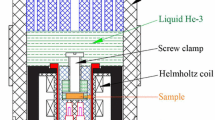Abstract
ac Susceptometry has been used to study a number of magnetic molecular solids including a new compound, Mn(II) octaethyltetraazaporphyrin, 6h-MnOETAP, and decamethylmanganocenium tetracyanoethenide, Mn(Cp*)2*TCNE, a previously reported molecule-based ferromagnet. Both of these compounds exhibit signatures of ferromagnetism including significant hysteresis below 2 K and rapidly increasing χT (where χ is the molar susceptibility) with decreasing temperature. However, their ac susceptibility data show relatively strong dependence of χs' and χ" on the frequency of the applied field, indicating a spinglass state. Other molecular ferromagnetic solids examined show much less sensitivity. These studies indicate that the standard practice of characterization by dc and ac susceptometry at a single frequency are clearly insufficient for identifying the magnetic state of a molecular solid.
Similar content being viewed by others
References
S. P. Sellers, B. J. Korte, J. P. Fitzgerald, W. M. Reiff and G. T. Yee, submitted to J. Am. Chem. Soc.
J. M. Robertson, J. Chem. Soc. 615 (1935) and 219 (1937)
B. N. Figgis, R. Mason, and G. A. Williams, Acta Crystallogr., Sect. B B36, 2963 (1980)
C. G. Barraclough, R. L. Martin and S. Mitra, J. Chem. Phys. 53 1638–1642 (1970)
S. Mitra, A. K. Gregson, W. E. Hatfield and R. R. Weller, Inorg. Chem. 22, 1729–1732 (1983).
G. T. Yee, J. M. Manriquez, D. A. Dixon, R. S. McLean, D. M. Groski, R. B. Flippen, K. S. Narayan, A. J. Epstein and J. S. Miller, Adv. Mater. 3, 309–311 (1991).
F. Palacio, F. J. Lazaro and A. J. van Duyneveldt, Mol. Cryst. Liq. Cryst. 176, 289–306 (1989).
C. M. Wynn, A. S. Albrecht, C. P. Landee, C. Navas and M. M. Turnbull, Mol. Cryst. Liq. Cryst. 274, 1–10 (1995).
Quantum Design Application Note #1, Sample Mounting.
J. A. Mydosh, Spin Glasses, An Experimental Introduction (Taylor and Francis, London, 1993).
C. M. Wynn, M. A. Girtu, W. B. Brinckerhoff, K.-I. Suguira, J. S. Miller and A. J. Epstein, Chem. Mater. 9, 2156–2163 (1997).
R. S. McLean, private communication. A Faraday balance was used to obtain these data. A large applied field improves signal to noise with this technique.
Acknowledgement
We thank Dr. Ron Goldfarb for many helpful discussions and the National Institute of Standards and Technology for use of the SQUID magnetometers. We acknowledge the Donors of the Petroleum Research Fund administered by the American Chemical Society for partial support of this work.
Author information
Authors and Affiliations
Rights and permissions
About this article
Cite this article
Sommer, R.D., Korte, B.J., Sellers, S.P. et al. Ac Susceptibility Studies of New and Familiar Magnetic Molecular Solids. MRS Online Proceedings Library 488, 471–476 (1997). https://doi.org/10.1557/PROC-488-471
Published:
Issue Date:
DOI: https://doi.org/10.1557/PROC-488-471




